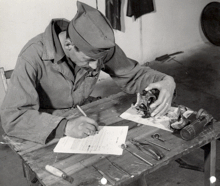
Arlington National Cemetery is one of two cemeteries in the United States National Cemetery System that are maintained by the United States Army. Nearly 400,000 people are buried in its 639 acres in Arlington County, Virginia.
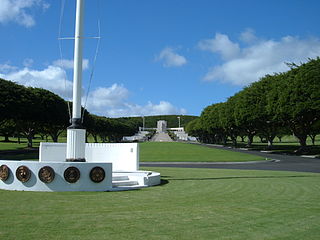
The National Memorial Cemetery of the Pacific is a national cemetery located at Punchbowl Crater in Honolulu, Hawaii. It serves as a memorial to honor those men and women who served in the United States Armed Forces, and those who have been killed in doing so. It is administered by the National Cemetery Administration of the United States Department of Veterans Affairs and is listed on the National Register of Historic Places. Millions of visitors visit the cemetery each year, and it is one of the most popular tourist attractions in Hawaii.

Missing in action (MIA) is a casualty classification assigned to combatants, military chaplains, combat medics, and prisoners of war who are reported missing during wartime or ceasefire. They may have been killed, wounded, captured, executed, or deserted. If deceased, neither their remains nor grave have been positively identified. Becoming MIA has been an occupational risk for as long as there has been warfare.

The Normandy American Cemetery and Memorial is a World War II cemetery and memorial in Colleville-sur-Mer, Normandy, France, that honors American troops who died in Europe during World War II. It is located on the site of the former temporary battlefield cemetery of Saint Laurent, covers 172.5 acres and contains 9,388 burials.

A war grave is a burial place for members of the armed forces or civilians who died during military campaigns or operations.
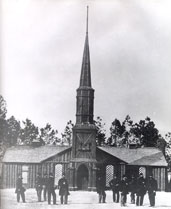
Poplar Grove National Cemetery is near Petersburg, Virginia, and is managed as part of Petersburg National Battlefield.
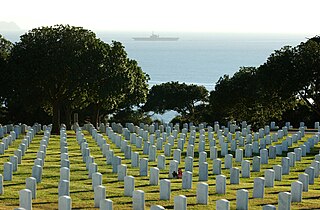
Fort Rosecrans National Cemetery is a federal military cemetery in the city of San Diego, California. It is located on the grounds of the former Army coastal artillery station Fort Rosecrans and is administered by the United States Department of Veterans Affairs. The cemetery is located approximately 10 miles (16 km) west of Downtown San Diego, overlooking San Diego Bay and the city from one side, and the Pacific Ocean on the other. Fort Rosecrans is named after William Starke Rosecrans, a Union general in the American Civil War. The cemetery was registered as California Historical Landmark #55 on December 6, 1932. The cemetery is spread out over 77.5 acres (31.4 ha) located on both sides of Catalina Blvd.

The United States Army Quartermaster Corps, formerly the Quartermaster Department, is a sustainment and former combat service support (CSS) branch of the United States Army. It is also one of three U.S. Army logistics branches, the others being the Transportation Corps and the Ordnance Corps.
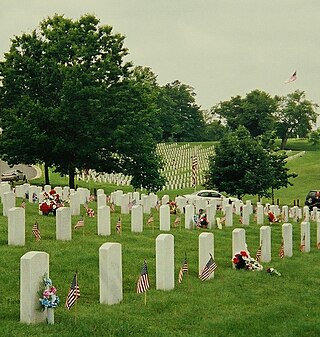
Camp Nelson National Cemetery is a United States National Cemetery located in southern Jessamine County, Kentucky. It was originally a graveyard associated with the U.S. Army's Camp Nelson, which was active during the U.S. Civil War and its aftermath. The camp was named for Major General William "Bull" Nelson, commander of the Civil War Army of Kentucky, who was murdered by a fellow officer in 1862.
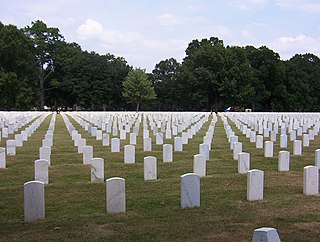
Memphis National Cemetery is a United States National Cemetery located in the Nutbush neighborhood in northeast Memphis, Tennessee. Administered by the United States Department of Veterans Affairs, it encompasses 44.2 acres (17.9 ha), and as of the end of 2007, had 42,184 interments.

Ardennes American Cemetery and Memorial is a Second World War American military war grave cemetery, located in the village of Neuville-en-Condroz, near the southeast edge of Neupré, some 20 km (12 mi) south-west of Liège in Belgium. The cemetery, dedicated in 1960, contains 5,329 American war dead and covers 90.5 acres (36.6 ha). It is one of three American war cemeteries in Belgium, the other two being at Flanders Field and Henri-Chapelle and is administered by the American Battle Monuments Commission (ABMC).
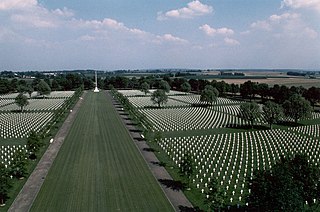
Netherlands American Cemetery and Memorial is a Second World War military war grave cemetery, located in the village of Margraten, 10 km (6.2 mi) east of Maastricht, in the most southern part of the Netherlands. The cemetery, the only American one in the Netherlands and dedicated in 1960, contains a constantly varying number above 8,000 American war dead and covers 65.5 acres (26.5 ha). It is administered by the American Battle Monuments Commission.

Orglandes War Cemetery is a German World War II cemetery in Normandy, France. It is located on the northern edge of the village of Orglandes, about 30 km (19 mi) south east of Cherbourg and 7 km (4.3 mi) west of Sainte-Mère-Église on the Cotentin Peninsula. The burials come from summer 1944, immediately following D-Day and the Battle of Normandy. It is the second smallest of the six German war cemeteries in Normandy with a little over 10,000 burials. The cemetery is maintained and managed by the voluntary German War Graves Commission.

Epinal American Cemetery and Memorial is a United States military cemetery in Dinozé, France. The 48.6 acres (19.7 ha) site rests on a plateau 100 feet (30 m) above the Moselle River in the foothills of the Vosges Mountains. It contains the graves of 5,255 of the United States' military dead, most of whom lost their lives in the campaigns across northeastern France to the Rhine and beyond into Germany during World War II.

Brookwood American Cemetery and Memorial is the only American Military Cemetery of World War I in the British Isles. Located approximately 28 miles (45 km) southwest of London, Brookwood American Cemetery contains the graves of 468 American war dead, including the graves of 41 unknown servicemen, from World War I.
The 59th Quartermaster Company is a bulk petroleum company designed to provide semi-portable storage for 2.5 million US gallons (9,500 m3) of fuel and to provide distribution of fuel to military units within a specified geographic area while deployed overseas. Its secondary mission is to provide an armed military escort to military cargo and civilian trucks during overseas contingency operations. It is a U.S. Army Forces Command combat service support unit stationed at Fort Carson, Colorado under the command of the 68th Combat Sustainment Support Battalion. The 59th has deployed overseas to Algeria, Italy, France, Germany, Korea, Vietnam, Kuwait, Saudi Arabia, Iraq, and Afghanistan. The 59th is the only bulk petroleum company in the Regular Army; all sister units are part of the Army Reserve as of 2011.

The United Nations Memorial Cemetery in Korea, located at Tanggok in the Nam District, City of Busan, Republic of Korea, is a burial ground for United Nations Command (UNC) casualties of the Korean War. It contains 2,300 graves and is the only United Nations cemetery in the world. Laid out over 14 hectares, the graves are set out in 22 sites designated by the nationalities of the buried servicemembers.
Operation Glory was an American effort to repatriate the remains of United Nations Command casualties from North Korea at the end of the Korean War. The Korean Armistice Agreement of July 1953 called for the repatriation of all casualties and prisoners of war, and through September and October 1954 the Graves Registration Service Command received the remains of approximately 4,000 casualties. Of the 1,868 American remains, 848 unidentified remains were buried as "unknowns" at the National Memorial Cemetery of the Pacific in Hawaii.
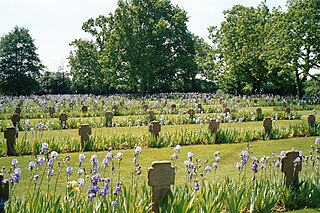
Saint-Désir-de-Lisieux is a Second World War German military war grave cemetery, located close to the village of Saint-Désir and 4 km (2.5 mi) west of Lisieux in the Calvados department, Normandy, France. It is located adjacent to the British Saint-Désir War Cemetery and is unique as the two burial grounds are linked by a pathway. It is the smallest German war cemetery in Normandy and contains the remains of 3,735 German military personnel. The cemetery was created by the British Graves Registration Commission in August 1944 with British and German casualties buried in adjacent fields.
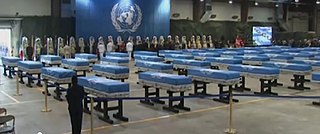
The recovery of US human remains from the Korean War has continued since the end of the war.
